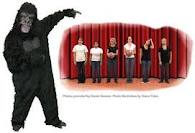The Invisible Gorilla
The essence of spirituality is seeing. The beginning assumption is: human beings are blind (read that dramatic story in John 9 of Jesus’ healing the man born blind!). We fail to see what’s right in front of us, which is why we keep making such deadly choices. It makes sense if you think, “Well of course she’s falling into every sad little ditch. She’s blind.”
Despite the popular notion, true spirituality does not reveal to you some esoteric vision of things heavenly. It simply opens your eyes to see the plain old reality under your nose. It’s just that—as all the masters keep telling us—when you actually look into “plain old reality” it shines like gold.
I am always fascinated by this strange, universal blindness. How is it possible that we can be staring right at it . . . and miss the shining gold?
I read this week about an experiment conducted by Christopher Chabris and Daniel Simons—detailed in their book, The Invisible Gorilla. They created a short film of two teams passing basketballs, one team wearing white shirts, the other wearing black. They ask people to watch the film, and instruct them to count the number of passes made by the white team, ignoring the black players. Doing this requires intense concentration. Halfway through the video, a woman wearing a gorilla suit appears, crosses the court, thumps her chest, and moves on. The gorilla is in view for nine seconds.
Thousands of people have watched the short video, and about half of them do not notice anything unusual. Chabris and Simons note that when these people are told about the gorilla, they insist it was not there. They cannot imagine missing an event that striking. Not only are we blind, we are adamant that we are not blind! Blind to our own blindness.
The reason for this gorilla-blindness is of course the intense focus on counting—only the white team’s passes. When we are so acutely trained on one thing we become effectively blind to other events, even something so wild as nine seconds of a chest-thumping gorilla.
Contemporary life has us similarly riveted: we are instructed to count only calories or dollars or SAT scores, only dress size or square footage or “hits.” To win at this game of life we know exactly what to keep our eye on, and that monomania blinds.
Think of it: what gorilla is walking through your family room, and no one can see it? What gorilla is thumping its chest in your bedroom? in the boardroom? Nine seconds. You can’t see it.

They say “seeing is believing.” But I attest that sometimes you have to believe before you can actually see. And I guess sometimes we don’t even see then….
An 800 pounder!
Right! Thanks, Dave.
So the remedy is to put on spiritual glasses and to stop counting some things and start counting more important stuff? Or just much less counting in general? I think this is interesting. I tend to find that I do a few things well, and “turn the blind eye” to other things I need to change. Perhaps I need spiritual bifocals?
You make a good point, Cathy. We have to focus on some things . . . which inevitably blinds us to other things. (In fact, our brain takes in millions of images and atomatically filters out nearly all of it, splicing together only a few images to present to our “vision.” So, it’s not possible to see everything, even if we wanted to!) For me, this experiment highlights the importance of a broad perceiving over a much more limited “counting.” If we can be aware of everthing, even as we have to focus on a few things now and a few more things later–if we can dance back and forth between the miscoscopic and the macroscopic–we’re far less likely to miss the great big important moments.
Spiritual BiFocals – What a great idea! Ginny